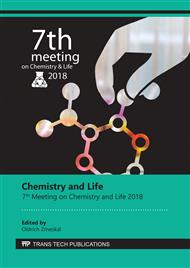[1]
M. Göppert-Mayer, Über Elementarakte mit zwei Quantensprüngen, Ann. Phys. (Leipzig) 9 (1931) 273.
DOI: 10.1002/andp.19314010303
Google Scholar
[2]
W. Kaiser, C.G.B. Garrett., Two-Photon Excitation in CaF2: Eu2+, Phys. Rev. Lett. 7 (1961) 229.
Google Scholar
[3]
S. Shima, R.P. Ilagan, N. Gillespie, B.J. Sommer, R.G. Hiller, F.P. Sharples, H.A. Frank, R.R. Birge, Two-Photon and Fluorescence Spectroscopy and the Effect of Environment on the Photochemical Properties of Peridinin in Solution and in the Peridinin-Chlorophyll-Protein from Amphidinium carterae, J. Phys. Chem. A 107 (2003) 8052-8066.
DOI: 10.1021/jp022648z
Google Scholar
[4]
M.P. Joshi, H.E. Pudavar, J. Swiatkiewicz, P.N. Prasad, B.A. Reianhardt, Three-dimensional optical circuitry using two-photon-assisted polymerization, Appl. Phys. Lett. 74 (1999) 170.
DOI: 10.1063/1.123283
Google Scholar
[5]
W. Zhou, S.M. Kuebler, K.L. Braun, T. Yu, J.K. Cammack, C.K. Ober, J.W. Perry, S.R. Marder, An Efficient Two-Photon-Generated Photoacid Applied to Positive-Tone 3D Microfabrication, Science 296 (2002) 1106-1109.
DOI: 10.1126/science.296.5570.1106
Google Scholar
[6]
F. Helmchen, W. Denk, Deep tissue two-photon microscopy, Nat. Methods 2 (2005) 932-940.
DOI: 10.1038/nmeth818
Google Scholar
[7]
S. Kawata, Y. Kawata, Three-Dimensional Optical Data Storage Using Photochromic Materials, Chem. Rev. 100 (2000) 1777-1788.
DOI: 10.1021/cr980073p
Google Scholar
[8]
J. W. Perry, S. Barlow, J.E. Ehrlich, A. Hekail, Z.Y. Hu, I.Y.S. Lee, K. Mansour, S. Marder, H. Röckel, M. Rumi, S. Thayumanavan, X.L. Wu, Two-photon and higher-order absorptions and optical limiting properties of bis-donor substituted conjugated organic chromophores, Nonlinear Opt. 21 (1999) 225-243.
DOI: 10.1364/ol.22.001843
Google Scholar
[9]
C. Bauer, B. Schnabel, E.B. Kley, U. Scherf, H. Giessen, R.F. Mahrt, Two-photon pumped lasing from a two-dimensional photonic bandgap structure with polymeric gain material, Adv. Mater. 14 (2002) 673-676.
DOI: 10.1002/1521-4095(20020503)14:9<673::aid-adma673>3.0.co;2-f
Google Scholar
[10]
M. J. Miller, S.H. Wei, I. Parker, M.D. Cahalan, Two-photon imaging of lymphocyte motility and antigen response in intact lymph node, Science 296 (2002) 1869-73.
DOI: 10.1126/science.1070051
Google Scholar
[11]
W. Dichtel J.M. Serin, C. Edder, J.M.J. Fréchet, M. Matuszewski, L.-S. Tan, T.Y. Ohulchanskyy, P.N. Prasad, Singlet Oxygen Generation via Two-Photon Excited FRET, J. Am. Chem. Soc. 126 (2004) 5380.
DOI: 10.1021/ja031647x
Google Scholar
[12]
P. N. Prasad, Nanophotonics, Wiley, New York (2004).
Google Scholar
[13]
K. Svoboda, R. Yasuda, Principles of two-photon excitation microscopy and its applications to neuroscience, Neuron 50 (2006) 823-839.
DOI: 10.1016/j.neuron.2006.05.019
Google Scholar
[14]
S. Luňák Jr., M. Vala, J. Vyňuchal, I. Ouzzane, P. Horáková, P. Možíšková, Z. Eliáš, M. Weiter, Absorption and fluorescence of soluble polar diketo-pyrrolo-pyrroles, Dyes and Pigments 91 (2011) 269-278.
DOI: 10.1016/j.dyepig.2011.05.004
Google Scholar
[15]
M. Vala, J. Krajcovic, S. Lunak, I. Ouzzane, J.P. Bouillon, M. Weiter, HOMO and LUMO energy levels of N,N'-dinitrophenyl-substituted polar diketopyrrolopyrroles (DPPs), Dyes and Pigmnets 106 (2014) 136-142.
DOI: 10.1016/j.dyepig.2014.03.005
Google Scholar
[16]
J. Kucerik, J. David, M. Weiter, m. Vala, J. Vynuchal, I. Ouzzane, O. Salyk. Stability and physical structure tests of piperidyl and morpholinyl derivatives of diphenyl-diketo-pyrrolopyrroles (DPP), JTAC 108 (2012) 467-473.
DOI: 10.1007/s10973-011-1896-8
Google Scholar
[17]
J. David, M. Weiter, M. Vala, J. Vynuchal, J. Kucerik, Stability and structural aspects of diketopyrrolopyrrole pigment and its N-alkyl derivatives, Dyes and Pigmnets 89 (2011) 137-143.
DOI: 10.1016/j.dyepig.2010.10.001
Google Scholar
[18]
M. Weiter, O. Salyk, P. Bednář, M. Vala, J. Navrátil, O. Zmeškal, J. Vyňuchal, S. Luňák Jr. Morphology and properties of thin films of diketopyrrolopyrrole derivatives, Mater. Sci. Eng. B-Solid State Mater. Adv. Technol. 165 (2009) 148-152.
DOI: 10.1016/j.mseb.2009.09.017
Google Scholar
[19]
M.A. Albota, C. Xu, W.W. Webb, Two-photon fluorescence excitation cross sections of bimolecular probes from 690 to 960 nm. Applied Optics 37 (1998) 7352-7356.
DOI: 10.1364/ao.37.007352
Google Scholar
[20]
T. Imoda, J. Mizuguchi, Strikingly different luminescent properties arising from single crystals grown from solution or from the vapor phase in a diketo-pyrrolo-pyrrole analog. J. Appl. Phys. 102 (2007) 073529(1)-073529(7).
DOI: 10.1063/1.2784996
Google Scholar
[21]
P. Kaatz, D.P. Shleton, Two-photon fluorescence cross-section measurements calibrated with hyper-Rayleigh scattering, J. Opt.Soc.Am. B 16 (1999) 998-1006.
DOI: 10.1364/josab.16.000998
Google Scholar
[22]
M. Pawlicki, H.A. Collins, R.G. Denning, H.L. Anderson. Two-photon absorption and the design of two-photon dyes, Angew. Chem. Int. Ed. 48 (2009) 3244-3266.
DOI: 10.1002/anie.200805257
Google Scholar
[23]
G.S. He, L.S. Tan, Q. Zheng, P.N. Prasad, Multiphoton Absorbing Materials: Molecular Design, Characterizations, and Applications, Chem. Rev. 108 (2008) 1245-1330.
DOI: 10.1021/cr050054x
Google Scholar
[24]
H.M. Kim, B.R. Cho, Two-photon materials with large two-photon cross sections. Structure-property relationship, Chem. Commun. 2 (2009) 153-164.
DOI: 10.1039/b813280a
Google Scholar
[25]
E.Q. Guo, P.H. Ren, Y.L. Zhang, H.C. Zhang, W.J. Yang, Diphenylamine end-capped 1,4-diketo-3,6-diphenylpyrrolo[3,4-c]pyrrole (DPP) derivatives with large two-photon absorption cross-sections and strong two-photon excitation red fluorescence, Chem. Commun. 39 (2009) 5859-5861.
DOI: 10.1039/b911808j
Google Scholar
[26]
S. Luňák Jr., L. Havel, J. Vyňuchal, P. Horáková, J. Kučerík, M. Weiter M, R. Hrdina, Geometry and Absorption of Diketo-Pyrrolo-Pyrroles Substituted with Various Aryls, Dyes and Pigments 85 (2010) 27-36.
DOI: 10.1016/j.dyepig.2009.09.014
Google Scholar
[27]
B. Strehmel, A.M. Sarker, H. Detert, The Influence of σ and π Acceptors on Two‐Photon Absorption and Solvatochromism of Dipolar and Quadrupolar Unsaturated Organic Compounds, ChemPhysChem 4 (2003) 249-259.
DOI: 10.1002/cphc.200390041
Google Scholar


